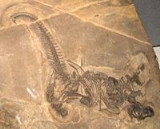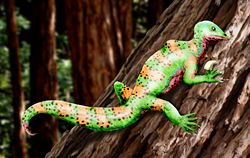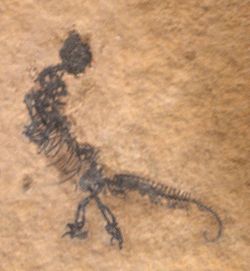
Drepanosauridae
Encyclopedia
Drepanosaurs are a group of strange reptile
s that lived during the Carnian
stage of the late Triassic Period, between 220 and 216 million years ago. The various species of drepanosaurid were characterized by odd specialized grasping limbs and often prehensile tails, adaptions for arboreal (tree-dwelling), and/or possibly aquatic lifestyles. Fossil
s of drepanosaurs, also known as Simiosaurs ("monkey lizards"), have been found in Arizona
, New Mexico
, New Jersey
, England
, and northern Italy
. The name is taken from the family's namesake genus
Drepanosaurus
, which means "sickle lizard", a reference to their strongly curved claws.
 Drepanosaurs are notable for their distinctive, triangular skulls, which resemble the skulls of bird
Drepanosaurs are notable for their distinctive, triangular skulls, which resemble the skulls of bird
s. Some drepanosaurs, such as Hypuronector
, had pointed, toothless, bird-like beak
s. This similarity to birds may have led to the possible mis-attribution of a drepanosaur skull to the would-be "first bird", Protoavis
.
Drepanosaurs featured a suite of bizarre, almost chameleon
-like skeletal features. Above the shoulders of most species was a specialized "hump" formed from fusion of the vertebrae, possibly used for advanced muscle attachments to the neck, and allowing for quick forward-striking movement of the head (perhaps to catch insects). Many had derived hands with two fingers opposed to the remaining three, an adaptation for grasping branches. Some individuals of Megalancosaurus
(possibly exclusive to either males or females) had a primate-like opposable toe on each foot, perhaps used by one sex for extra grip during mating. Most species had broad, prehensile tails, sometimes tipped with a large "claw", again to aid in climbing. These tails, tall and flat like those of newt
s and crocodile
s, have led some researches to conclude that they were aquatic rather than arboreal. In 2004, Senter dismissed this idea, while Colbert and Olsen, in their description of Hypuronector, state that while other drepanosaurs were probably arboreal, Hypuronector was uniquely adapted to aquatic life. The tail of this genus was extremely deep and non-prehensile – much more fin-like than members of the more exclusive group Drepanosauridae
.

 Drepanosaurs have been difficult to pin down in terms of their phylogenetic position. They have been assigned by some resarches to the prolacertiformes
Drepanosaurs have been difficult to pin down in terms of their phylogenetic position. They have been assigned by some resarches to the prolacertiformes
, though more recent studies place them together with the coelurosauravids
and Longisquama
in a clade
called the Avicephala
.
Within Avicephala, Senter created the group Simiosauria to refer to all the species traditionally grouped together within the Drepanosauridae
, reserving that name for a more exclusive sub-group. Senter found that Hypuronector
, originally described as a drepanosaurid, actually lies just outside that clade, along with the primitive drepanosaur Vallesaurus
. He also recovered a close relationship between the drepanosaurids Dolabrosaurus
and Megalancosaurus
.
The following cladogram
was found by Senter in his 2004 analysis.
Renesto et al. (2010) demonstrated that Senter (2004) cladogram was based on poorly defined characters and dataset. The resulting phylogeny was therefore very unusual compared to any other previous study on drepanosaurs or related taxa. The new cladogram proposed in this last study abandoned both Avicephala
(because it is polyphyletic) and Simiosauria. Senter's definition of Simiosauria included Sauria
as an external specifier, causing the clade to become obsolete in Renesto et al.s study (where drepanosaurs nested within Sauria). Renesto and colleagues instead defined a new clade, Drepanosauromorpha, as the least
inclusive clade containing Hypuronector limnaios and Megalancosaurus pronenesis. Another more inclusive taxon, Elyurosauria ("lizard with coiled tails"), was erected, in order to include all the drepanosaurs with coiled tails, Vallesaurus
is thus more derived than Hypuronector
(as clearly shown by its morphology). Drepanosaurus
and Megalancosaurus
are also in a new taxon named Megalancosaurinae.
The alternative cladogram presented in Renesto et al. (2010).
Reptile
Reptiles are members of a class of air-breathing, ectothermic vertebrates which are characterized by laying shelled eggs , and having skin covered in scales and/or scutes. They are tetrapods, either having four limbs or being descended from four-limbed ancestors...
s that lived during the Carnian
Carnian
The Carnian is the lowermost stage of the Upper Triassic series . It lasted from about 228.7 till 216.5 million years ago . The Carnian is preceded by the Ladinian and is followed by the Norian...
stage of the late Triassic Period, between 220 and 216 million years ago. The various species of drepanosaurid were characterized by odd specialized grasping limbs and often prehensile tails, adaptions for arboreal (tree-dwelling), and/or possibly aquatic lifestyles. Fossil
Fossil
Fossils are the preserved remains or traces of animals , plants, and other organisms from the remote past...
s of drepanosaurs, also known as Simiosaurs ("monkey lizards"), have been found in Arizona
Arizona
Arizona ; is a state located in the southwestern region of the United States. It is also part of the western United States and the mountain west. The capital and largest city is Phoenix...
, New Mexico
New Mexico
New Mexico is a state located in the southwest and western regions of the United States. New Mexico is also usually considered one of the Mountain States. With a population density of 16 per square mile, New Mexico is the sixth-most sparsely inhabited U.S...
, New Jersey
New Jersey
New Jersey is a state in the Northeastern and Middle Atlantic regions of the United States. , its population was 8,791,894. It is bordered on the north and east by the state of New York, on the southeast and south by the Atlantic Ocean, on the west by Pennsylvania and on the southwest by Delaware...
, England
England
England is a country that is part of the United Kingdom. It shares land borders with Scotland to the north and Wales to the west; the Irish Sea is to the north west, the Celtic Sea to the south west, with the North Sea to the east and the English Channel to the south separating it from continental...
, and northern Italy
Italy
Italy , officially the Italian Republic languages]] under the European Charter for Regional or Minority Languages. In each of these, Italy's official name is as follows:;;;;;;;;), is a unitary parliamentary republic in South-Central Europe. To the north it borders France, Switzerland, Austria and...
. The name is taken from the family's namesake genus
Genus
In biology, a genus is a low-level taxonomic rank used in the biological classification of living and fossil organisms, which is an example of definition by genus and differentia...
Drepanosaurus
Drepanosaurus
Drepanosaurus is a genus of arboreal reptile that lived during the Triassic Period. Only one specimen of Drepanosaurus has thus far been found. Sadly this specimen was incomplete and lacked a head and neck...
, which means "sickle lizard", a reference to their strongly curved claws.
Description

Bird
Birds are feathered, winged, bipedal, endothermic , egg-laying, vertebrate animals. Around 10,000 living species and 188 families makes them the most speciose class of tetrapod vertebrates. They inhabit ecosystems across the globe, from the Arctic to the Antarctic. Extant birds range in size from...
s. Some drepanosaurs, such as Hypuronector
Hypuronector
Hypuronector is a genus of extinct reptile from the Triassic Period that lived in what is now New Jersey. The etymology of the name translates as "deep-tailed swimmer from the lake." A member of the Simiosauria, Hypuronector is related to the arboreal Megalancosaurus. It was a small animal,...
, had pointed, toothless, bird-like beak
Beak
The beak, bill or rostrum is an external anatomical structure of birds which is used for eating and for grooming, manipulating objects, killing prey, fighting, probing for food, courtship and feeding young...
s. This similarity to birds may have led to the possible mis-attribution of a drepanosaur skull to the would-be "first bird", Protoavis
Protoavis
Protoavis is a problematic taxon of archosaurian known from fragmentary remains from Late Triassic Norian stage deposits near Post, Texas. Much controversy remains over the animal, and there are many different interpretations of what Protoavis actually is...
.
Drepanosaurs featured a suite of bizarre, almost chameleon
Chameleon
Chameleons are a distinctive and highly specialized clade of lizards. They are distinguished by their parrot-like zygodactylous feet, their separately mobile and stereoscopic eyes, their very long, highly modified, and rapidly extrudable tongues, their swaying gait, the possession by many of a...
-like skeletal features. Above the shoulders of most species was a specialized "hump" formed from fusion of the vertebrae, possibly used for advanced muscle attachments to the neck, and allowing for quick forward-striking movement of the head (perhaps to catch insects). Many had derived hands with two fingers opposed to the remaining three, an adaptation for grasping branches. Some individuals of Megalancosaurus
Megalancosaurus
Megalancosaurus is a genus of extinct reptile from the Late Triassic period of Northern Italy, and one of the best known drepanosaurids. The type species is M. preonensis; a translation of the animal's scientific name would be "long armed reptile from the Preone Valley."-Anatomy:Megalancosaurus was...
(possibly exclusive to either males or females) had a primate-like opposable toe on each foot, perhaps used by one sex for extra grip during mating. Most species had broad, prehensile tails, sometimes tipped with a large "claw", again to aid in climbing. These tails, tall and flat like those of newt
Newt
A newt is an aquatic amphibian of the family Salamandridae, although not all aquatic salamanders are considered newts. Newts are classified in the subfamily Pleurodelinae of the family Salamandridae, and are found in North America, Europe and Asia...
s and crocodile
Crocodile
A crocodile is any species belonging to the family Crocodylidae . The term can also be used more loosely to include all extant members of the order Crocodilia: i.e...
s, have led some researches to conclude that they were aquatic rather than arboreal. In 2004, Senter dismissed this idea, while Colbert and Olsen, in their description of Hypuronector, state that while other drepanosaurs were probably arboreal, Hypuronector was uniquely adapted to aquatic life. The tail of this genus was extremely deep and non-prehensile – much more fin-like than members of the more exclusive group Drepanosauridae
Drepanosauridae
Drepanosaurs are a group of strange reptiles that lived during the Carnian stage of the late Triassic Period, between 220 and 216 million years ago. The various species of drepanosaurid were characterized by odd specialized grasping limbs and often prehensile tails, adaptions for arboreal , and/or...
.

Classification

Prolacertiformes
Prolacertiformes were an order of archosauromorph reptiles that lived during the Permian and Triassic Periods...
, though more recent studies place them together with the coelurosauravids
Coelurosauravidae
Coelurosauravidae was a family of avicephalans from the Permian and Triassic time periods. They lived in trees, and were typically two feet long...
and Longisquama
Longisquama
Longisquama insignis is an extinct lizard-like reptile known only from one poorly preserved and incomplete fossil. It lived during the middle or late Triassic Period, 230-225 million years ago, in what is now Kyrgyzstan...
in a clade
Clade
A clade is a group consisting of a species and all its descendants. In the terms of biological systematics, a clade is a single "branch" on the "tree of life". The idea that such a "natural group" of organisms should be grouped together and given a taxonomic name is central to biological...
called the Avicephala
Avicephala
thumb|right|Artist's reconstruction of [[Coelurosauravus]]Avicephala is a possibly polyphyletic and therefore disused clade of diapsid reptiles that lived during the Late Permian and Triassic periods...
.
Within Avicephala, Senter created the group Simiosauria to refer to all the species traditionally grouped together within the Drepanosauridae
Drepanosauridae
Drepanosaurs are a group of strange reptiles that lived during the Carnian stage of the late Triassic Period, between 220 and 216 million years ago. The various species of drepanosaurid were characterized by odd specialized grasping limbs and often prehensile tails, adaptions for arboreal , and/or...
, reserving that name for a more exclusive sub-group. Senter found that Hypuronector
Hypuronector
Hypuronector is a genus of extinct reptile from the Triassic Period that lived in what is now New Jersey. The etymology of the name translates as "deep-tailed swimmer from the lake." A member of the Simiosauria, Hypuronector is related to the arboreal Megalancosaurus. It was a small animal,...
, originally described as a drepanosaurid, actually lies just outside that clade, along with the primitive drepanosaur Vallesaurus
Vallesaurus
Vallesaurus is an extinct genus of Late Triassic elyurosaur drepanosauromorph. First found in Northern Italy in 1975, it is one of the most primitive drepanosaurs. V. cenenis is the type species, named in 2006. A second species, V...
. He also recovered a close relationship between the drepanosaurids Dolabrosaurus
Dolabrosaurus
Dolabrosaurus is a genus of extinct reptile and a member of the family Drepanosauridae....
and Megalancosaurus
Megalancosaurus
Megalancosaurus is a genus of extinct reptile from the Late Triassic period of Northern Italy, and one of the best known drepanosaurids. The type species is M. preonensis; a translation of the animal's scientific name would be "long armed reptile from the Preone Valley."-Anatomy:Megalancosaurus was...
.
The following cladogram
Cladogram
A cladogram is a diagram used in cladistics which shows ancestral relations between organisms, to represent the evolutionary tree of life. Although traditionally such cladograms were generated largely on the basis of morphological characters, DNA and RNA sequencing data and computational...
was found by Senter in his 2004 analysis.
Renesto et al. (2010) demonstrated that Senter (2004) cladogram was based on poorly defined characters and dataset. The resulting phylogeny was therefore very unusual compared to any other previous study on drepanosaurs or related taxa. The new cladogram proposed in this last study abandoned both Avicephala
Avicephala
thumb|right|Artist's reconstruction of [[Coelurosauravus]]Avicephala is a possibly polyphyletic and therefore disused clade of diapsid reptiles that lived during the Late Permian and Triassic periods...
(because it is polyphyletic) and Simiosauria. Senter's definition of Simiosauria included Sauria
Sauria
Sauria is a clade of reptiles that includes all living diapsids, as well as their common ancestor and all its extinct descendants. The ancestral saurian was probably a small lizard-like creature living in the Permian Period...
as an external specifier, causing the clade to become obsolete in Renesto et al.s study (where drepanosaurs nested within Sauria). Renesto and colleagues instead defined a new clade, Drepanosauromorpha, as the least
inclusive clade containing Hypuronector limnaios and Megalancosaurus pronenesis. Another more inclusive taxon, Elyurosauria ("lizard with coiled tails"), was erected, in order to include all the drepanosaurs with coiled tails, Vallesaurus
Vallesaurus
Vallesaurus is an extinct genus of Late Triassic elyurosaur drepanosauromorph. First found in Northern Italy in 1975, it is one of the most primitive drepanosaurs. V. cenenis is the type species, named in 2006. A second species, V...
is thus more derived than Hypuronector
Hypuronector
Hypuronector is a genus of extinct reptile from the Triassic Period that lived in what is now New Jersey. The etymology of the name translates as "deep-tailed swimmer from the lake." A member of the Simiosauria, Hypuronector is related to the arboreal Megalancosaurus. It was a small animal,...
(as clearly shown by its morphology). Drepanosaurus
Drepanosaurus
Drepanosaurus is a genus of arboreal reptile that lived during the Triassic Period. Only one specimen of Drepanosaurus has thus far been found. Sadly this specimen was incomplete and lacked a head and neck...
and Megalancosaurus
Megalancosaurus
Megalancosaurus is a genus of extinct reptile from the Late Triassic period of Northern Italy, and one of the best known drepanosaurids. The type species is M. preonensis; a translation of the animal's scientific name would be "long armed reptile from the Preone Valley."-Anatomy:Megalancosaurus was...
are also in a new taxon named Megalancosaurinae.
The alternative cladogram presented in Renesto et al. (2010).
External links
- Monkey Lizards of the Triassic - An illustrated article on drepanosaurs from HMNH.
- Prof. Silvio Renesto—Vertebrate Paleontology at Insubria University: Research - Images and discussion of Drepanosaurus.
- Prof. Silvio Renesto—Vertebrate Paleontology at Insubria University: Research - Images and discussion of Megalancosaurus.

